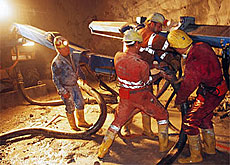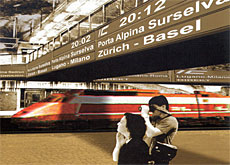Faster than flying

The new Gotthard rail link is set to bring northern and southern Europe much closer together.
When the whole line is finished in 2015, the current journey time from Zurich to Milan will be halved.
Switzerland’s involvement in the project is part of its commitment to build two new transalpine rail links: one at the Gotthard, and the other at the Lötschberg in canton Bern. The aim is to ease the pressure on roads through the Alps.
The rail link is one of the largest and most ambitious construction projects ever seen in Europe. The new Gotthard tunnel alone will be 57 kilometres long, making it the longest rail tunnel in the world.
To get the tunnel ready on schedule up to 1,500 construction workers are on site at any one time. They work shifts 24 hours a day, seven days a week.
“This is one of the most challenging tasks I have ever worked on,” said Simon Peggs, a civil engineer.
“We are constructing the straightest, most direct link, from north to south,” he told swissinfo. “It’s a key point for Europe.”
Traditionally tunnel construction involves two teams of excavators starting work at either end of a tunnel. But the new Gotthard is so long that it has been divided into five sections, all of which are being dug simultaneously.
“We are using tunnel-boring machines,” explained Peggs. “And they can dig out between 15 and 20 metres a day.”
“The volume of rock we have to move to build the tunnel is five times greater than that used to build the Cheops pyramid in Egypt.”
Safety first
Getting the tunnel ready on time and within budget are major concerns, as is the safety of all those working on the project.
“The weight of the rock pressing down on top of the tunnel forces the temperature inside to rise to 45 degrees centigrade,” said Peggs. “So we have to cool things down to around 28 degrees.”
“In addition we have to blow fresh air into the underground construction site, because we have a lot of engines down there. Our ventilation system blows in 200 cubic metres of fresh air every second.”
Fears about tunnel safety in general were raised two years ago following the deadly fire in the Gotthard road tunnel, in which 11 people died.
The new Gotthard rail tunnel will in fact have two separate tubes, one for trains heading north to south, and the other for those travelling in the opposite direction. And there will be two emergency stations, with additional access tunnels.
History of hazardous travel
Throughout history, travellers have faced many dangers trying to cross the Alps, the natural barrier separating northern and southern Europe.
The most direct route from Germany to Italy is through Switzerland, via the Gotthard, and it is known that the pass was used at least as early as the 12th century.
“It was an extremely risky journey,” explained Carlo Peterposten, curator of the museum that now stands at the top of the pass.
“There were mule tracks across the pass,” he told swissinfo. “But in fact you only travelled by mule if you were rich – everyone else went on foot.”
Close to the museum is a small church, known as the “Chapel of the Dead”, in which the remains of many of those who died crossing the pass are interred.
“It’s strange for us to imagine it now,” explained Peterposten. “But in those times the pass was nearly always open, right through the winter. And in fact it was most heavily used in winter, by Italian workers going north looking for work.”
Faster than flying
The new rail link will mark an enormous change from the days of slogging it over the Alps on foot.
The high-speed trains will travel at up to 250 kilometres an hour through the tunnel. To enable the trains to reach such speeds, the entire line from Zurich to Milan runs at a constant 500 metres above sea level and is almost dead straight.
There is no corkscrewing track, as with the old Gotthard railway line, because modern trains simply cannot get up to speed on such lines.
“When this line is finally finished, the journey between Zurich and Milan will be reduced from four and half hours to less than two and a half hours,” said Simon Peggs.
“That’s faster than flying.”
swissinfo, Imogen Foulkes
The new Gotthard rail tunnel will be 60 kilometres long, making it the longest train tunnel in the world.
It is expected to cost around SFr15 billion and should to come into service in 2015.
The volume of rock moved to create the tunnel will be five times larger than the Cheops pyramid in Egypt.
The high-speed rail link will halve the journey time between Zurich and Milan.
The cruel alpine winter claimed the lives of many trying to cross the Gotthard.
Cesar Lombardi, who as young boy in the 1850’s lived near the top of the pass, recorded his memories of going out with his father to help a Swiss soldier trying to get over the pass by moonlight.
“I accompanied my father…to where the tired man was. He was sitting on a lump of frozen snow holding a walking stick with both hands and his face leaning forward, apparently asleep.
“My father shook him by the shoulder to wake him up and he fell on the roadway stiff as a marble statue. He was, of course, frozen dead.”

In compliance with the JTI standards
More: SWI swissinfo.ch certified by the Journalism Trust Initiative

You can find an overview of ongoing debates with our journalists here. Please join us!
If you want to start a conversation about a topic raised in this article or want to report factual errors, email us at english@swissinfo.ch.